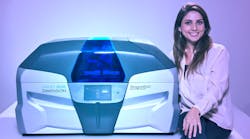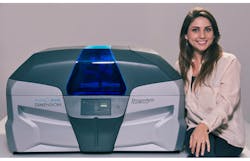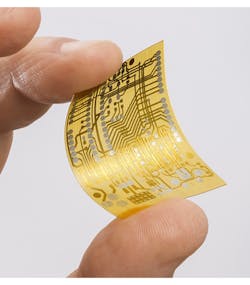Q&A: A Behind-the-Scenes Look at the DragonFly 2020 3D Printer
This file type includes high-resolution graphics and schematics when applicable.
Lena Kotlar, R
The founders of Nano Dimension, CEO Amit Dror and Chief Business Officer Simon Fried, decided they wanted to create the first professional 3D Printer for printed electronics applications. For that, they turned to Lena Kotlar, fresh out of Israel’s Bezalel Academy of Art and Design in Jerusalem, where she specialized in industrial design. The result was the DragonFly 2020 3D Printer (Fig. 1) that prints printed circuit boards (PCBs).
I was able to talk to Lena Kotlar about her project that combines technological advances in inkjet3D printing technology, advanced nanotechnology-based conductive and dielectric inks, along with sophisticated software to deliver the ultimate rapid-prototyping tool. The 3D printer can create functional multilayer PCBs (Fig. 2).
Wong: What led you to take on this project at Nano Dimension as your first job after graduation?
Kotlar: Design is about making something better. It can fix a lot of things and can even change the world. I wanted to help solve a big problem and make a real difference by being part of a team providing valuable innovative solutions to the electronics market. Nano Dimension offered me the opportunity to help change the world of printed electronics.
My first task was to design a desktop system that helps make production of professional multilayer printed circuit boards faster, easier and more innovative, eliminating the many challenges of traditional PCB manufacturing. The DragonFly 2020 3D Printer, our unique system for professional electronics, was developed to offer enterprises significant time and cost savings. It makes it possible to produce high-quality, functional circuits in hours rather than weeks. This printer eliminates setup costs, material waste and IP security risks stemming from outsourcing. It can also provide endless options for creativity and innovation in the PCB industry, allowing PCB designers to completely rethink how they create boards.
1. The DragonFly 2020 3D Printer is designed to print multilayer PCBs from scratch, including vias.
Wong: What sort of PCBs can customers produce with the DragonFly 2020 3D Printer?
Kotlar: Electronics designers and engineers can now rapidly 3D-print complex multilayer boards with classic vias as either blind, open, or complete paths of conductive material, with no need for drilling. In the future, they will be able to design an electronic product and then 3D-print the PCB accordingly to match the design, which will completely change how electronic products are developed.
Wong: From a design perspective, why focus on 3D printing?
Kotlar: 3D printing is at the forefront of new product design and technical innovation. The benefits can come in the form of the ability to produce more complex, highly integrated geometries as well as material and design optimization, opening up new opportunities for higher-performance products and uniquely designed products and prototypes.
Wong: Can you discuss what influenced you in your design of the DragonFly 2020 3D Printer and how you tackled the design process?
Kotlar: The design of the DragonFly 2020 3D Printer draws inspiration from nature, the automotive industry, and Nano Dimension’s dragonfly logo. The main design feature is the division between the center and side sections of the system, achieved through a hexagon shape that mimics the wings and body of our dragonfly logo and captures the straight sloped lines of a powerful Lamborghini sports car. The non-bulky, streamlined, desktop system was designed in shades of gray and blue that resemble the colors of the Nano Dimension brand.
The system features a blue transparent “see-through” upper body part that has an intuitive touchscreen, and lights up to show the 3D-printing process in action. The result is an elegant 3D printer with a powerful appearance that brings together all of the essential hardware, software, and system integration components of a high-resolution enterprise 3D printer.
2. Printed circuit boards like that shown are made possible with the DragonFly 2020.
Wong: How long did it take to design the DragonFly 2020 3D Printer, and what design tools did you use?
Kotlar: Despite its complexity, the DragonFly was designed in just 17 months. Every bit of the unit—mechanical parts, the housing, wires and cables—was designed using SOLIDWORKS. The software’s simulation capabilities were used to ensure the parts would work correctly together and the unit would function properly while building 3D PCBs.
Wong: What are some of the product design elements that your product team focused on?
Kotlar: Development of rapid-prototyping systems for electronics is an extremely complicated process. The high-resolution system needs to be efficient, practical, and user-friendly. The system is designed to print a maximum size of 20- × 20- × 0.3-cm boards and support anything up to 3 mm, which is more than 20 layers. This enables production of high-speed, multifunction, high-capacity, and small-size PCBs for rapid prototyping.
Wong: What kinds of reactions are you getting to the DragonFly now that there’s been lots of news published about it?
Kotlar: So far, the response has been phenomenal. The DragonFly 2020 3D Printer offers a very applicable solution to several very clear pain points. Manufacturers adopting this system expect a variety of gains, including cutting their time to market with new products and speeding iterations and innovation around PCBs. They are very excited.
Wong: In terms of innovation, what is Nano Dimension doing to make sure it stays at the forefront of the industry?
Kotlar: Innovation is a continual process for us and one that Nano Dimension lives and breathes every day. There is a great deal going on behind the scenes in terms of continuing to develop unique technologies for jetting, curing, higher-resolution traces and a broader materials portfolio. Looking to the future, there are very exciting times ahead for the company.
Lena Kotlar, R&D Mechanical Manager at Nano Dimension, received her degree from Israel’s Bezalel Academy of Art and Design in Jerusalem, where she specialized in industrial design. Lena Kotlar’s first project at Nano Dimension was to design the DragonFly 2020 3D Printer.






